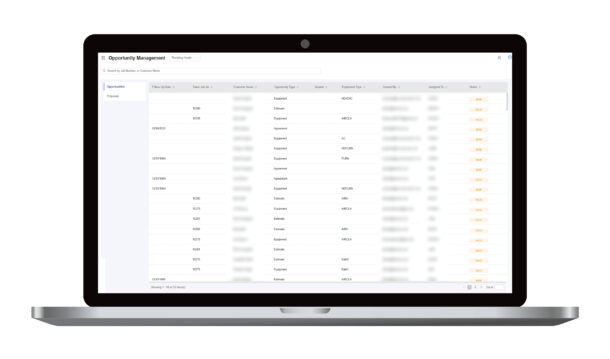For tradespeople, success hinges not just on technical expertise but on the quality of their relationships with clients. In a market where skills are often on par across the board, delivering exceptional customer service can set a tradesperson apart from the competition. Not only can excellent service enhance client satisfaction, but also it can foster Read more
Customer Relationship Management (CRM)

For tradespeople, success hinges not just on technical expertise but on the quality of their relationships with clients. In a market where skills are often on par across the board, delivering exceptional customer service can set a tradesperson apart from the competition. Not only can excellent service enhance client satisfaction, but also it can foster repeat business and build a stellar reputation, all of which are essential for sustained success.
Below, we’ll go over seven tips for enhancing customer service and promoting stronger relationships in the trades.
-
Provide Clear Communication
First and foremost, being clear and communicative is crucial in the trades industry, where the specifics of the work might not be easily understood. Effective communication involves keeping clients well informed about job details, timelines, possible disruptions and progress. The better communication, the fewer misunderstandings and dissatisfaction. By making sure clients are consistently updated and feel listened to, tradespeople lay a foundation of trust and respect, which is indispensable for maintaining long-lasting business relationships.
-
Manage Expectations
Transparency from the start is key to building relationships as well. Tradespeople should be open with clients about what can realistically be accomplished given the available resources and time. Discussing limitations and setting clear, achievable goals right from the first meeting helps prevent client frustration with the final outcome. This approach also builds trust and minimizes the risk of negative feedback, thereby safeguarding the tradesperson’s reputation.
-
Exceed Client Needs
“Wowing” clients involves going beyond the basic requirements to provide service that adds real value to their lives. Whether it’s accommodating a client’s schedule or providing additional maintenance tips after the job is done, these actions enhance client satisfaction and loyalty, increasing the likelihood of repeat business and recommendations. For example, in sewer repair, a tradesperson might offer a complimentary follow-up inspection to confirm everything is functioning correctly and there are no further concerns. This approach makes the customer feel well cared for and valued.

-
Provide Proactive Problem-Solving
Generally, this relationship-building strategy requires anticipating potential issues and addressing them before they become problematic. This might mean advising on future risks to a plumbing or electrical system and how to avoid them. Showing foresight in this manner demonstrates that the provider is invested, not just in the immediate job but also in the client’s long-term welfare. This approach works to solidify a tradesperson’s reputation as thoughtful and reliable, encouraging clients to develop a lasting professional relationship.
-
Personalize the Client Experience
Making the whole process feel made to order can make a world of difference. This approach entails showing respect as well as a thorough understanding of individual client needs and preferences. It goes beyond remembering names; it’s about adapting communication styles, integrating personal preferences and showing genuine interest and respect for their space and time. Personalized service makes clients feel uniquely valued and cared for, significantly enhancing their overall experience and satisfaction.
-
Offer Flexible Solutions
Being able to accommodate different budgets and needs demonstrates a tradesperson’s adaptability and commitment to client satisfaction. By tailoring solutions to individual circumstances, tradespeople build stronger relationships and enhance their reputation as considerate and client-focused professionals. This flexibility can significantly increase client trust and encourage long-term loyalty.
-
Follow Up Consistently
Regular check-ins with clients after the completion of a job help confirm they remain satisfied. This is not just to address potential issues but also to offer continued support and advice. Such follow-up can transform a one-time job into an ongoing service relationship, providing tradespeople with a steady stream of loyal customers.
Cementing Success Through Service Excellence
Strong client relationships are the backbone of a thriving trade business. Putting these tactics into practice helps guarantee that clients are not only satisfied but also delighted with the service they receive. This in turn builds a better relationship and even encourages positive referrals.
Put simply, by prioritizing top-notch customer service today, tradespeople are investing in a prosperous and reputable tomorrow.
 Kareem Haddad is the owner of Absolute Rooter & Plumbing, a family-owned and operated company that has been improving the plumbing systems of Orange County and surrounding areas since 2010.
Kareem Haddad is the owner of Absolute Rooter & Plumbing, a family-owned and operated company that has been improving the plumbing systems of Orange County and surrounding areas since 2010.

Small business owners recognize the value of a powerful Customer Relationship Management (CRM) tool. Storing and tracking customer communication history, job data, maintenance agreements, equipment history, and more, the right CRM can help a business grow its customer base and increase revenue. Many of us are most familiar with CRM software and its benefits as Read more
Small business owners recognize the value of a powerful Customer Relationship Management (CRM) tool. Storing and tracking customer communication history, job data, maintenance agreements, equipment history, and more, the right CRM can help a business grow its customer base and increase revenue.
Many of us are most familiar with CRM software and its benefits as it relates to our sales teams. After all, they tend to be the primary users on a daily basis, capturing a wealth of useful customer information. But that same CRM data is a hidden gem for the marketing department as well.
Marketers have their work cut out for them these days. As attentions are scattered across more and more communication platforms, it has become necessary to increase marketing frequency. In fact, a potential customer usually requires about eight touches from a business or brand before a sale happens. Whether a business is looking to develop effective email marketing content, implement automation to assist with hands-free outreach or determine ROI on a campaign, CRM has tools available to help.
Just remember: it’s imperative to obtain the proper permissions from both current and potential customers before adding them to a marketing list. Once that step is taken care of, it’s time to start brainstorming your next marketing campaign and the messages you want to convey to these two different audiences.
For prospective customers, messaging is typically geared towards communicating why you are the best company and why they should want to do business with you. This is the time to separate your business from the competition, making a memorable impression that will stick with them when they go to book their next service appointment.
Since current customers are already familiar with your company and its services, the marketing message usually revolves around offering them special promotions or maintenance service agreements. Businesses may also want to provide them with helpful tips and advice that further position the company as the provider of choice in the industry and market.

CRM Tool #1 – Segment contacts for email marketing
Email newsletters can be a cost-effective marketing campaign solution to convey these different messages to both prospective and current customers. Email can help build relationships with customers and keep them coming back, and they are fairly easy to start. Even better, segmenting contacts into potential customers and current customers is generally accomplished easily within CRM systems.
For prospective customers, a newsletter is a place to feature your company’s products and services, as well as the expertise of your team. You can also include the ever-popular coupons or discounts, which typically attract new customers. They are also a great way to help increase awareness of services your company offers that people may not know about. If there is a type of job you offer but rarely have any customers who book appointments for it, offer a discount and see if it helps with awareness. Discounts are also effective for current customers who may be looking for a deal when it’s time to book an appointment.
Email newsletters also allow marketers to monitor the engagement they are achieving with these important contacts. By tracking open rates and click-through rates, a business can see what content is resonating. Sales can even use that information to follow up with a customer who may have clicked on an offer or link in the email but have not yet booked an appointment or service.
Establishing a routine cadence of email newsletter communication means your list of contacts will be seeing your brand’s name on a regular basis. Your company will be top-of-mind the next time they need a service you offer.
CRM Tool #2 – Automation
CRMs can help with automating outreach such as service reminders for upcoming appointments, maintenance agreement expirations/renewals, or reminders to schedule upcoming maintenance agreement visits. Some CRMs have the ability to create automated email sequences that potential customers will receive at predetermined intervals.
Consider automating a thank you email once a service is complete and including a link to review your business. Remind your customers that the best way to say thanks is by leaving a positive review. If they have easy access to leave a review, customers will be more likely to do so. Establishing a reputation for providing excellent service will go a long way in attracting new customers.
CRM Tool #3 – Track ROI and Lifetime Value
Over time, CRM systems will provide data that helps track the lifetime value of customers and marketing campaigns. Knowing where a customer came from, whether it was a form, website, social media, ad, etc., results in several things.
First, it allows a business to track where it gets the most leads and customer inquiries. Ads may be running on multiple channels, such as social media or local broadcast outlets. Compiling the information on where the leads are coming from helps determine where it’s worth investing more money. If an ad is not performing as well and not resulting in many customer inquiries, you may want to consider stopping the ad and putting that money towards a platform where you see a return.
Businesses can also begin to track the lifetime value of a customer based on jobs they have completed or any maintenance agreements they have. Seeing how much revenue and profit that customer has driven over time and tracking that back to the lead source helps a business determine the lifetime value of its marketing campaigns and lead sources.
These are just some of the ways CRM software can be used to develop effective marketing plans and create new marketing tools that will help recruit and retain customers. Don’t let the sales team have all the fun with CRM; encourage your marketing team to start accessing all of that valuable customer information today.
 Chris O’Grady has been in sales for 30 years, focusing on software sales for the last 20. Chris has been leading and growing sales teams for most of his career, with his most recent positions at FinancialForce and CBORD, where he led high-performing sales teams and was able to help drive tremendous growth for each company. In April 2022, Chris joined Successware as the Chief Sales Officer. He brought with him a proven history of business growth and increased sales performance. In his current role, Chris leads sales, sales operations, and customer success and is responsible for driving sales strategy.
Chris O’Grady has been in sales for 30 years, focusing on software sales for the last 20. Chris has been leading and growing sales teams for most of his career, with his most recent positions at FinancialForce and CBORD, where he led high-performing sales teams and was able to help drive tremendous growth for each company. In April 2022, Chris joined Successware as the Chief Sales Officer. He brought with him a proven history of business growth and increased sales performance. In his current role, Chris leads sales, sales operations, and customer success and is responsible for driving sales strategy.
